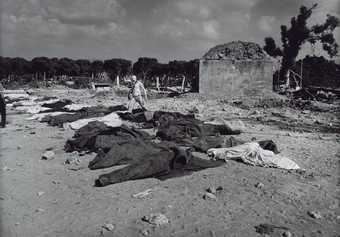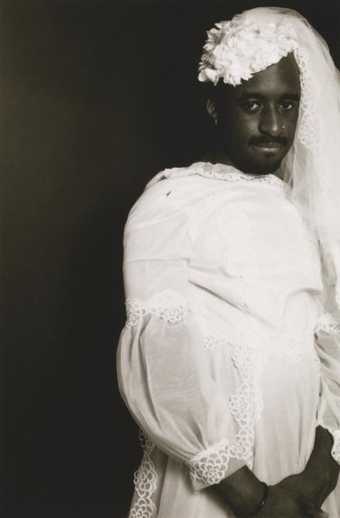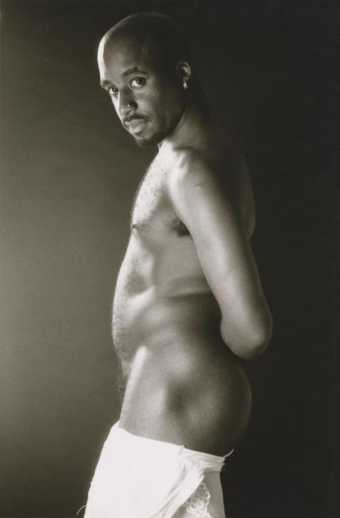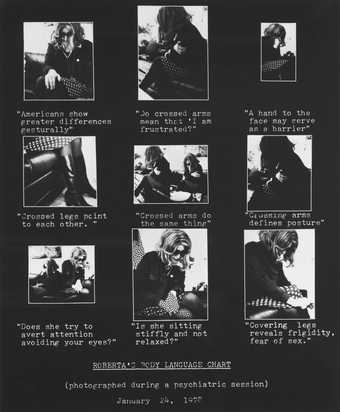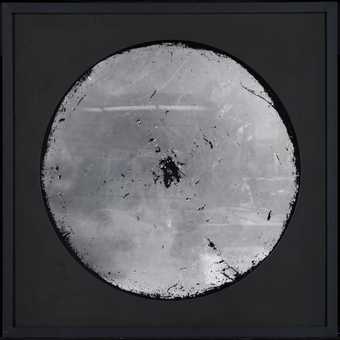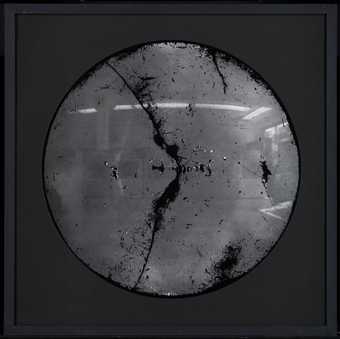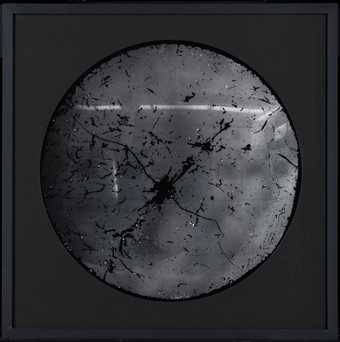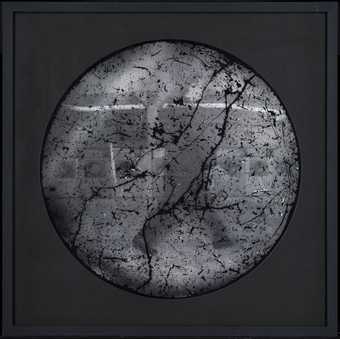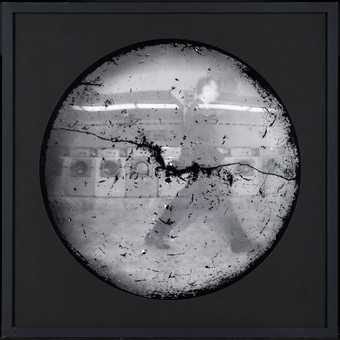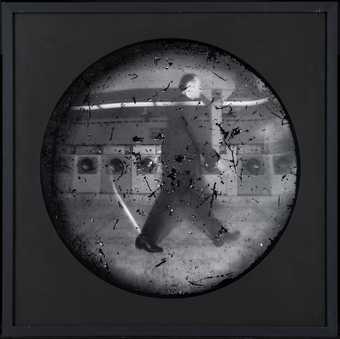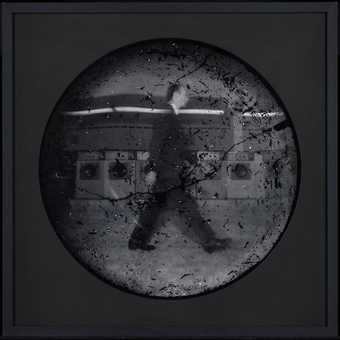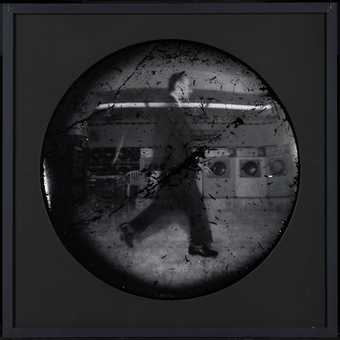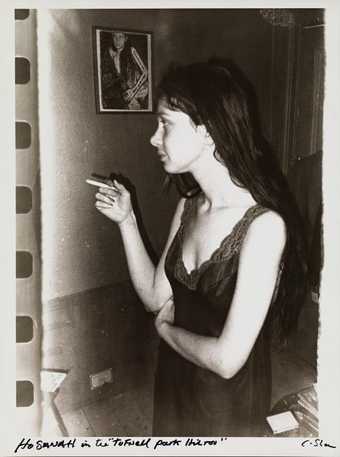
Not on display
- Artist
- Ajamu born 1963
- Medium
- Photograph, gelatin silver print on paper
- Dimensions
- Image: 255 × 381 mm
support: 303 × 405 mm - Collection
- Tate
- Acquisition
- Presented by Tate Members 2020
- Reference
- P82577
Summary
Bodybuilder in Bra 1990 is a black and white photograph by the British photographer Ajamu. It exists in an edition of three, of which Tate’s copy is number three. It shows a close-up view of a muscular black back, the anonymous bodybuilder of the title. His arms are raised overhead and cropped at the triceps, and only the back of his neck and lower part of his head are shown. He wears a white bra that is tightly stretched around the core of his body, its straps twisted over his shoulders and its white fabric contrasting against his black skin. The raised arms suggest an action shot but the deep black background and deliberate studio lighting indicate otherwise. This image captures Ajamu’s distinctive approach to portraying gender and masculinity, while giving insight into the artist’s playful and spontaneous way of working. When asked about the photoshoot, Ajamu said: ‘we went to the local market here in Brixton, bought a bra and played around with it. This was one of the first shots.’ (Ajamu, conversation with Tate curator Mels Evers, 5 September 2019). This spontaneity is contrasted with the carefully balanced, painterly close-up of the black body. The intimate portrait of an unknown sitter invites the viewer to become a voyeur and in this way references the work of French surrealist photographer Pierre Molinier (1900–1976). In an interview for the catalogue of the exhibition Kiss My Genders at the Hayward Gallery, London in 2018, in which his work was included, Ajamu said:
The one artist I keep coming back to, decade after decade, is Pierre Molinier. There was an exhibition of his work at Cabinet Gallery in Brixton in 1993. I was totally bowled over by it, partly because it was confusing – I couldn’t work out where Pierre was in the image, and there are times his body has morphed. It not only played around with gender, it explored fetishism, voyeurism and spectatorship.
(In Kiss My Genders, exhibition catalogue, Hayward Gallery, London 2018, pp.9–17.)
Bodybuilding has long been an area of interest for Ajamu and, in an earlier interview in 2003, he described how it has ‘become an archetypal image of the male body’. He went on to explain how his practice has been ‘a consistent attempt to subvert, re-think, play with these limited modes of representations around particular bodies in a multi-dimensional way’ (in Ajamu X and Naoko Pilgrim 2003, p.112). Bodybuilder in Bra has arguably become the artist’s most iconic work and is often reproduced in publications. In 2018 the British Nigerian multi-media artist Evan Ifekoya (born 1988) positioned the work at the centre of their own solo exhibition Ritual Without Belief at Gasworks, London. In doing so, they explicitly referenced the impact of this work on a new generation of black queer artists working in the United Kingdom.
Bodybuilder in Bra was shown in Ajamu’s solo exhibition Black Bodyscapes that opened at Camerawork, London in 1994 and continued to tour to Huddersfield Art Gallery and Aytoun Gallery in Manchester. Also included were Self-Portrait in Wedding Dress 1 1993 (Tate P15460) and Self-Portrait in Wedding Dress 2 1993 (Tate P15461), also in Tate’s collection. The exhibition was attended by the prominent cultural theorist Stuart Hall who noted:
Ajamu’s bodyscapes face the contradictions of ‘black masculinity’ full-on. They re-figure the black body as the subject of fluid scenes of prohibited pleasure. His approach is openly confrontational and ‘in your face’: he challenges the view to follow him into looking at the extremes of sexual pleasure and desire. His ‘subject’ is queer transgression, and his purpose is to ‘re-claim’ the most far-out of bodily pleasures. Ajamu’s images are provocatively cross-gendered, working for an effect of extreme dissonance.
(Stuart Hall, in Hall and Sealy 2001, pp.44–5.)
Ajamu’s practice centres around the historic and current (in)visibility of the black queer community in the United Kingdom. His photographs often include male models from the artist’s personal circle, as is the case here, and most of them were shot in the artist’s studio and home in Brixton, south London. Ajamu has always developed his photographs in his own darkroom and the developing process has increasingly become a central part of his practice. When the artist is not working with models, he often places his own body at the centre of the work, something which results in direct and sometimes confrontational images.
Further reading
Deborah Bright, The Passionate Camera: Photography and Bodies of Desire, London 1998.
Stuart Hall and Mark Sealy, Different: A Historical Context: Contemporary Photographers and Black Identity, London 2001.
Ajamu X and Anita Naoko Pilgrim, ‘In Conversation: Photographer Ajamu and Cultural Critic Anita Naoko Pilgrim’, Paragraph, vol.26, no.1/2, Men’s Bodies, March–July 2003.
Mels Evers
March 2020
Does this text contain inaccurate information or language that you feel we should improve or change? We would like to hear from you.
You might like
-
Sir Don McCullin CBE After the Massacre of Sabra Camp in Beirut
1982, printed 2013 -
Ajamu Self-portrait in Wedding Dress 1
1993 -
Ajamu Self-portrait in Wedding Dress 2
1993 -
Lynn Hershman Leeson Roberta’s Body Language Chart
1978; printed 2009 -
Steven Pippin Laundromat-Locomotion (Walking in Suit)
1997 -
Steven Pippin Laundromat-Locomotion (Walking in Suit)
1997 -
Steven Pippin Laundromat-Locomotion (Walking in Suit)
1997 -
Steven Pippin Laundromat-Locomotion (Walking in Suit)
1997 -
Steven Pippin Laundromat-Locomotion (Walking in Suit)
1997 -
Steven Pippin Laundromat-Locomotion (Walking in Suit)
1997 -
Steven Pippin Laundromat-Locomotion (Walking in Suit)
1997 -
Steven Pippin Laundromat-Locomotion (Walking in Suit)
1997 -
Steven Pippin Laundromat-Locomotion (Walking in Suit)
1997 -
Steven Pippin Laundromat-Locomotion (Walking in Suit)
1997

